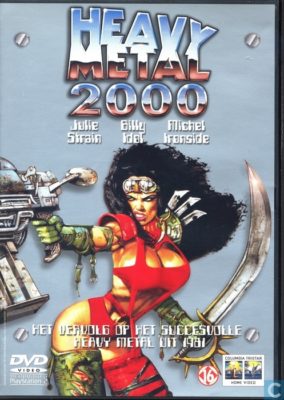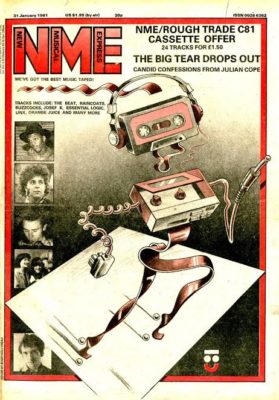This isn’t good at all.
It’s barely even a movie: it’s like a long episode of Batman: The Animated Series featuring an occasional boob and a soundtrack of angsty, edgy mallcore. Music was shit-awful in the year 2000, and if you need a reminder, the first Slipknot album is shorter by thirty minutes, so listen to that instead.
What connection does it share to the original Heavy Metal? The title.
Instead of being an anthology, it contains a single bad story based on a graphic novel by Teenage Mutant Ninja Turtles co-creator Kevin Eastman. The plot (narrated by someone who was probably making dramatic hand gestures in the vocal booth), involves the Arakacians producing an elixir of immortality and a secret key lost in space and a villainous asteroid miner and a tertiary villain who’s a dinosaur and an xtreme grrl heroine and a second xtreme grrl heroine and a plucky comic relief character who later becomes a sidekick and is replaced by a different plucky comic relief and a plot MacGuffin and Guy DeBord and Roland Barthes and asdf
The film is overloaded with detail and characters, because it’s basically a 170 page graphic novel jammed into a VHS player with a shoehorn. The screenplay couldn’t have more holes if it was made of swiss cheese. Where does the villainous Tyler get the weapons he uses for the raid on Eden? Why do none of those futuristic space-guns appear in the final showdown, which is fought with spears and swords? Why does becoming evil cause your hair to grow twenty inches?
Action girl #1 is played by Julia Strain. She has boobs. She beats the shit out of people who look at her boobs. What more character development do you need? Tyler himself looks like Ruber from 1998’s dose of box office strychnine Quest for Camelot, and exemplifies the problem I have with almost all “crazy” cartoon villains (such as Batman’s Joker): he turns sane and calculating whenever the plot requires it. The result is a mechanical artifice of a film where you can feel the interference of the writer on every frame. Why do characters do anything in Heavy Metal 2000? Kevin Eastman wanted them to do it.
“Calculating” applies to the film in general. There’s none of the sense of liberty and freedom of the original – instead it’s like a cold-eyed gambler, hedging every bet.
A great example is the SHOCKING ADULT CONTENT…which isn’t integrated in any way to the story! 95% of the film is a bland Saturday morning cartoon, then we get a pointless splash of violence and nudity, then the movie becomes a Saturday morning cartoon again. This is obviously intentional: they set up the movie so they could quickly chop all objectionable content and get a PG-13 rating. The quislings.
The animation is TV quality. Suffice to say that 90s cartoons looked as shitty as 90s music sounded: Heavy Metal 2000 is dark, lacks contrast, and has the palette of an Excedrin headache. Enjoy your browns, grays, and khaki greens. This is like playing Quake, right down to the underwhelming final boss.
This underscores the biggest offense Heavy Metal 2000 commits: it isn’t fun. Ren & Stimpy creator John Kricfalusi once said something (aside from “I thought she was 18, your honor”) that I find profound: animation’s strength is that it creates visuals that would be impossible with live action. If you animate visuals that are even more drab and bland than real life, you’re ignoring the possibilities of the medium. Heavy Metal 2000 doesn’t just ignore the possibilities, it hoists the black flag and directly repudiate them. What an ugly fucking film.
Heavy Metal was only barely successful. Heavy Metal 2000 went direct-to-video, and should have gone direct-to-landfill. It killed off attempts to bring Metal Hurlant to life for nearly another 20 years, before an anthology called Love, Death & Robots appeared on Netflix. I haven’t seen it and probably won’t: it’ll likely be a pandering joke full of references to Twitter and trans issues, with a villain called “Tonaald D’rump” or some shit. Heavy Metal is a nostalgic look at the past. As such, it’s best left in the past. The world did not and still does not need another Heavy Metal.
No Comments »
Drop a stone in a pond. Ripples will spread out. Cultural events are similar, but sometimes the ripples occur before the stone falls. Facebook, iPhones, and The Lord of the Rings (books, not movies) are stones. Myspace, Blackberries, and The Hobbit (book, not movies) are ripples. Although important in their own right, they had the misfortune to occur before a similar (but much bigger) thing, and have been swallowed by it within the public mind.
Cassette tapes (and the culture surrounding them) were ripples: the stone would would fall twenty years later. They were ugly plastic rectangles containing about ninety meters of magnetic tape. Music recorded on them usually sounded hissy and noisy (this itself became an aesthetic), but the tapes were so cheap that it was now possible for the average child to copy music. People would tape songs off the radio (complete with hacky DJ voices and commercials), as well as make illegal bootlegs of live bands. This led to a full-blown kulturkampf between tapers and record labels in the 1980s, culminating in the BPI’s often-parodied “Home Taping Is Killing Music” slogan.

Some labels fought cassette tapes, but others embraced them. C81 (a compilation cassette released by NME at the start of the tape boom) is an example of the latter, containing twenty-four tracks of British and American “indie” music circa 1981. I’m sure that all the bands involved were branded as sellouts until their dying day.
The tracklisting is as schizophrenic and scattered as any fourteen year old’s mixtape: legends like Pere Ubu and Scritti Politti exist alongside bizarre “art” projects like Furious Pig that apparently did nothing notable except appear on C81. It’s both ethnically and musically diverse, with selections of funk, ska, reggae, dub and so on. Also, whoever put this together clearly wanted to fuck Lora Logic, because she’s on here twice.
As with many compilations, it sprays and it prays. “You won’t like everything, but you’ll probably like something.” I enjoyed the apocalyptic mini-epic “The Seven Thousand Names of Wah!”, the histrionic but understated “Shouting Out Loud”, the Scritti Politti song, and “Parallel Lines”, which is a thesis on everything punk should be: taught, fraught, and small.
But the best piece of music C81 has to offer is Cabaret Voltaire’s “Raising the Count”, which initiates the listener into a kind of electronic Satanic ritual: a black mass powered by 200 watts. The song is as destructively repetitive as a pneumatic drill rammed through your basilar membrane. You will either turn it off in confusion, or get sucked into a hypnogogic state. Cabaret Voltaire had existed for most of a decade by the time C81 came out, and would continue to release music for about twelve more years (although I find their later techno/house music to be less interesting than their early experimental work).
So, good music, and good capture of a particular moment in British musical history. C81 is now most easily acquired in digital form, which was the next evolutionary stage of tape culture. Cassette tapes were ripples, and digital piracy was the stone, doing everything cassettes had done (including killing the music business) about two orders of magnitude more successfully. The record industry profiting off tape trading seems gruesomely poetic in retrospect. It’s as though Louis XVI, before the French Revolution, had invested royal money in guillotines.
No Comments »
I decided to watch the 1981 animated film Heavy Metal because of its reputation.
Like Vegemite and the blonde German chanteuse on the first Velvet Underground album, Heavy Metal doesn’t have an especially good or a bad reputation; it merely has one. It grossed $20.1 million on a $9.3 million budget, enough to be considered a mild hit but not enough for a sequel. It has 6.7/10 on IMDB and a 60% Rotten Tomatoes score (critics’ consensus: “sexist, juvenile, and dated”).
It’s based upon the Heavy Metal comics anthology, which in turn is derived upon Métal Hurlant, the legendarily explicit French outfit home to everyone from Paolo Eleuteri Serpieri to Moebius; the film adapts stories from the comics, which vary from erotica to science fiction to horror. The art style changes from segment to segment, ranging from itchy “realistic” rotoscoped footage to stuff that could be a Saturday morning cartoon.
I watched it once. It made an impression. I watched it again. I decided I really liked it.
Halfway through my third rewatch, I thought this is my favorite movie of all time.
Heavy Metal is spellbinding yet rationally hard to defend. I like it more than any movie I’ve ever seen, but what intellectual case can be made for it? It’s embarrassing. There’s actually a story about a dweeb who visits a fantasy world, gains huge muscles, and has sex with hot babes. The art is sometimes excellent but more often workmanlike. The “groovy, man” tone of the writing hasn’t aged well. If “auteurness” is important to you, this lacks the personality of a Bakshi film or the polish of a Don Bluth. I have no idea who the individual directors are, or what they did before or sense. So what does it have that makes it special?
It has heart. Sincerity. It throws itself before the mercy of the court and receives a pardon. Heavy Metal elicits the nostalgia-drenched emotions of a beloved childhood film that I haven’t seen in twenty years, but I first saw it ten months ago. How’s that possible? How can you be Pavlov’s dog and salivate before you hear the bell?
“Soft Landing” is a stop-motion music video depicting a Corvette falling from orbit and landing in a field.
“Grimaldi” provides the framing device: a glowing green orb called the Loc-Nar (“the sum of all evils”) hypnotizes a young girl and shows her visions of the devastation it has wrought across time and space. These visions form the remainder of the film’s shorts. I hate it when words seem like anagrams but aren’t, and “Loc-Nar” is such a word.
“Harry Canyon” is the hard-luck tale of a New York cab driver in 2031 (ten years away!), driving aliens and vaporising mugs. He gets tangled up with a pretty young moll who’s on the run from the local goon squad (representative line: “Here I was, stuck with this beautiful girl. I knew she was gonna be nothin’ but trouble”). Might be mistaken as a parody of noir crime, but Heavy Metal is too earnest to parody anything.
“Den” is an adolescent nerd power fantasy. Describing the plot in detail would cause me to break out in pimples and start expressing strong opinions about D&D 5th Ed, so I’ll just say that it’s charming and pleasant, with a wonderful final shot. Den has the voice (but not the physique) of John Candy.
“Captain Sternn”‘s eponymous hero is in a jam. He’s on trial for 12 counts of murder, 22 counts of robbery, 37 counts of rape, et cetera. He thinks he has a plan to get off the hook (no, it doesn’t involve getting a job in the TRUMP ADMINISTRATION, ha ha), but as usual the Loc-Nar appears and ruins everything. Entertaining but lightweight, “Captain Stern” is the only segment that could have been cut without dramatically worsening the film. But it’s cute.
“B-17”, by contrast, is horrific. The pilot of a WWII bomber is flying home after a sortie, only to notice that everyone on his plane has died. Or have they? Gruesome and unredeeming, it’s similar to the Aldapuerta short story “Ikarus”, as well as the Twilight Zone episode “Terror at 20,000 Feet”. Great art, and a sense of doom as thick as squid ink.
“So Beautiful & So Dangerous” is about a babelicious fox/foxelicious babe who gets abducted by aliens and decides she’s into anal probes. I haven’t read the original comic but there’s clearly piles of story being left on the cutting room floor – we never learn what’s causing the mutations, for example. You have to leave room for tits and drug references, and this has plenty of both.
“Taarna” is an epic that closes off the film and resolves the story of the Loc-Nar. A peaceful people are on the verge of being slaughtered, and the warrior maiden Taarna rides to save them. It’s a heavily compressed version of a Moebius story, with continuity errors appearing at a rate of about two a minute (random example: how does Taarna get her sword back after escaping the pit?), but its flaws are obliterated by its grand, epic heft. The short evokes nigh-apocalyptic size: seeing this on a big screen must have been something. There’s some gorgeous panoramic shots of landscapes where every grain of sand seems to be animated – were computers involved? The final few minutes are a masterclass in color: bloody battles against an incarnadine sky, sickly green as the Loc-Nar makes its final stand, and a final shot of black splashed with faint colour: hope still exists, but you have to reach for it, into the stars.
Describing anything in Heavy Metal is a waste of time: all I can do is describe my reaction to it, which is beyond positive. Heavy Metal stands alone. It needs every concession ever made, and gets them. I don’t care if it objectively sucks, I don’t care if you think the comics were better: this is the best movie ever made by human hands.
No Comments »




